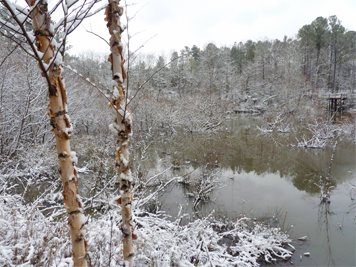Spring is wound up and ready to pop!
Sure, it was colder than usual the first two months of this year. And, it seems as though it has snowed more this year than within memory. It’s predicted to snow today!

But, there’s much evidence pointing to a new season springing forth. The days are getting longer. Both the maples and elms are ready to burst open their buds and Hazel Alder is nearly in full flower.

The sun is coming up earlier and setting later. Chorus Frogs and Spring Peepers are calling and Pickerel Frogs have been seen slowly moving about the landscape. More and more turtles are coming out to bask in the afternoon sun, both Yellow-bellied Sliders and Painted Turtles.

I saw a solitary wasp in a sunny spot of the trail in Catch the Wind and a paper wasp flew by me in the Wetlands.
On my drive in to the Museum recently I saw two different Red-tailed Hawks carrying nesting material. The two Brown-headed Nuthatches that were digging a hole in a Loblolly Pine in Catch the Wind at the beginning of this month are at it again, this time on the opposite side of the same tree.

Listen for the nuthatch’s squeaky-toy calls in the pines as you walk around throughout the outdoor areas of the Museum.
Northern Cardinals have been singing for the past month and, according to Exhibits Tech David, one was seen carrying nesting material last week. I heard the first singing Red-winged Blackbird of the season on the 19th of February. Tufted Titmice are singing their clear-whistled, repetitive notes. Pine Warblers are in song. And, I heard a Song Sparrow briefly trying out its repertoire of rolling trills.
A small band of some two dozen Cedar Waxwings attempted to storm the small hollies next to the Ornithopter for their berries. The Leonardo da Vinci inspired ride in Catch the Wind was too much for the little waxwings; its huge white wings flapping back and forth next to the hollies kept the birds at bay.

These waxwings arrived four days earlier than last year’s nomadic troop of over 400 that descended on the hollies growing next to the main Museum Building.
Purple Martins have been observed within our borders. These birds are early arrivals, for sure, but the rest of their species is definitely on its way north.
From this point on things will move quickly. New arrivals from the south will appear, fresh new leaves will begin to emerge, snakes, insects…I can’t wait!
I have Brown-headed Nuthatches nesting in an ornamental birdhouse in my back yard. I can hear the hatchlings so I hope I can get a few shots of the family.
Keep your eye on the nest, things happen quickly with these small birds. Let me know if and when you post the pictures.
Thanks
You mention the hawks carrying nesting materials. Is this the time of year they mate? I heard two hawks (which I think were actually Cooper’s hawks) calling back and forth to each other in my backyard last Saturday. I usually only hear one at a time so I was wondering if it was because of mating/rearing. When would the babies hatch?
Red-tailed Hawks may mate for life. Last month I noticed some aerial displays over the Museum by Red-tails. This swooping, diving, and talon-locking behavior was the hawk’s getting acquainted, or getting re-acquainted, period. The hawks then settle into nest building, or re-building if the same nest is used from the previous year, which may very likely be the case.
I don’t know the exact dates for egg laying but I suspect that there will be eggs in the nest in March. Incubation is about a month, so sometime in April there will be little Red-tailed Hawks peeking over the edges of nests throughout our area loudly sqauwking for food. It will probably be another month or more before they fly.
I can’t say for sure what you heard in your yard. It’s possible that they were Cooper’s Hawks. However, Cooper’s Hawks are the least vocal of the other three locally nesting hawks that could be heard at this time of year. Red-shouldered Hawks are the most vocal and can be heard throughout the year. They too are gearing up for the nesting season. The calls of those two species are quite different.
By the way, we’ve had Cooper’s Hawks nesting here at the Museum for at least the past two years. Both nests successfully reared young.
Enjoy.